A Culex quinquefasciatus mosquito on a human finger.
The Culex quinquefasciatus mosquito is proven to be a vector associated with transmission of the West Nile Virus.
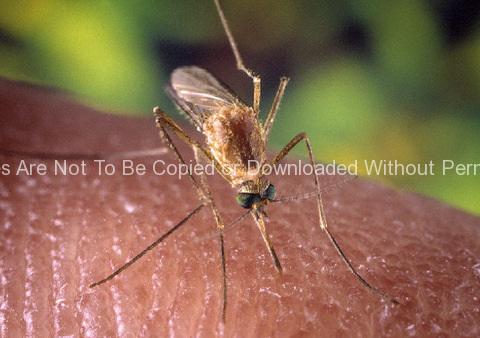
A Culex quinquefasciatus mosquito on a human finger.
The Culex quinquefasciatus mosquito is proven to be a vector associated with transmission of the West Nile Virus.
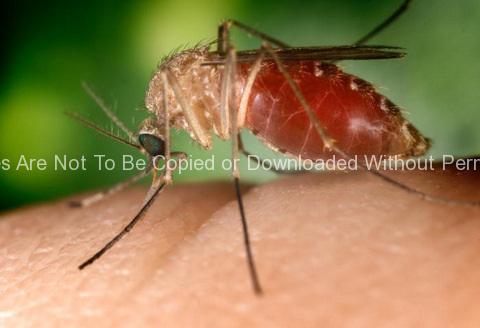
Known as a vector for the West Nile virus, this Culex quinquefasciatus mosquito has landed on a human finger.
The main transmitter of the West Nile virus in the southeast is the species C. quinquefasciatus. Eliminating puddles and small containers of water can greatly reduce this mosquito’s population.
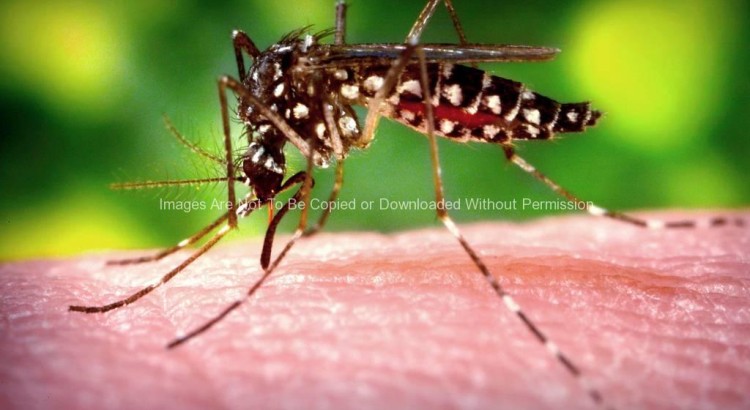
This image depicted a female Aedes aegypti mosquito as she was obtaining a blood-meal from a human host through her fascicle, which being transparent, reflected the blood’s red color. As it filled with blood, the abdomen became distended, thereby, stretching the exterior exoskeletal surface, causing it to become transparent, and allowing the collecting blood to become visible as an enlarging intra-abdominal red mass.
DF and DHF are primarily diseases of tropical and sub-tropical areas, and the four different dengue serotypes (DEN-1, DEN-2, DEN-3, and DEN-4), are maintained in a cycle that involves humans and the Aedes mosquito. However, Aedes aegypti, a domestic, day-biting mosquito that prefers to feed on humans, is the most common Aedes species. Infections produce a spectrum of clinical illness ranging from a nonspecific viral syndrome to severe and fatal hemorrhagic disease. Important risk factors for DHF include the strain of the infecting virus, as well as the age, and especially the prior dengue infection history of the patient.
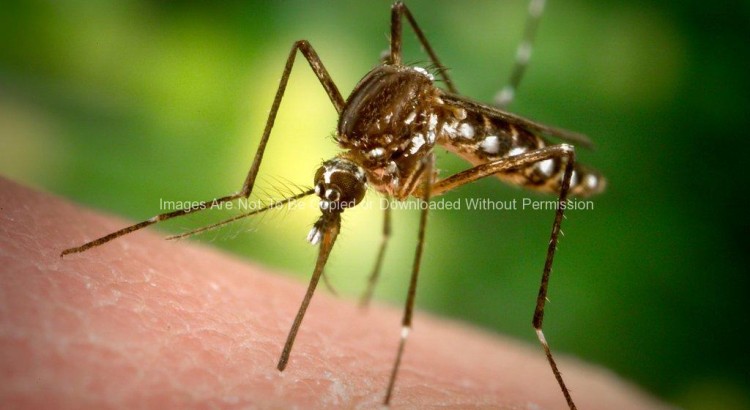
This photograph depicted a female Aedes aegypti mosquito as she was in the process inserting her fascicle through the skin surface of her host. She then proceeded to obtain a “blood meal.”As it would fill with blood, the abdomen would become distended, thereby, stretching the exterior exoskeletal surface, causing it to become transparent, and allowing the collecting blood to become visible as an enlarging red mass.
As the primary vector responsible for the transmission of the Flavivirus Dengue (DF), and Dengue hemorrhagic fever (DHF), the day-biting Aedes aegypti mosquito prefers to feed on its human hosts. Ae. aegypti also plays a major role as a vector for another Flavivirus, “Yellow fever”. Frequently found in its tropical environs, the white banded markings on the tarsal segments of its jointed legs, though distinguishing it as Ae. aegypti, are similar to some other mosquito species. Also note the lyre-shaped, silvery-white markings on its thoracic region as well, which is also a determining morphologic identifying characteristic.

This photograph depicted a female Aedes aegypti mosquito as she was in the process of acquiring a blood meal from its human host, after having penetrated the skin surface with the sharply-pointed “fascicle”. Note that her abdomen had become distended as her stomach was filling with her blood meal, and how the proboscis’ labial sheath was in its retracted, pulled back configuration, exposing the inserted, sharp fascicle, which had turned red, as the blood was passing up the straw-like apparatus.
As the primary vector responsible for the transmission of the Flavivirus Dengue (DF), and Dengue hemorrhagic fever (DHF), the day-biting Aedes aegypti mosquito prefers to feed on its human hosts. Ae. aegypti also plays a major role as a vector for another Flavivirus, “Yellow fever”. Frequently found in its tropical environs, the white banded markings on the tarsal segments of its jointed legs, though distinguishing it as Ae. aegypti, are similar to some other mosquito species. Also note the lyre-shaped, silvery-white markings on its thoracic region as well, which is also a determining morphologic identifying characteristic
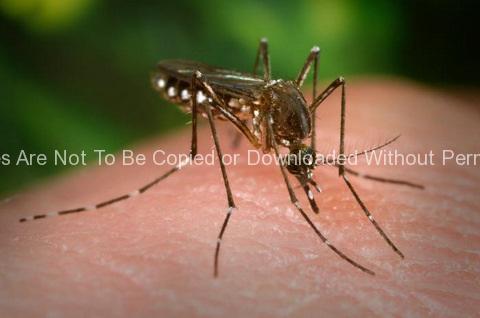
This photograph depicted a female Aedes aegypti mosquito as she was in the process of seeking out a penetrable site on the skin surface of its host. As it would fill with blood, the abdomen would become distended, thereby, stretching the exterior exoskeletal surface, thereby, causing it to become transparent, and allowing the collecting blood to become visible as an enlarging red mass.
As the primary vector responsible for the transmission of the Flavivirus Dengue (DF), and Dengue hemorrhagic fever (DHF), the day-biting Aedes aegypti mosquito prefers to feed on its human hosts. Ae. aegypti also plays a major role as a vector for another Flavivirus, “Yellow fever”. Frequently found in its tropical environs, the white banded markings on the tarsal segments of its jointed legs, though distinguishing it as Ae. aegypti, are similar to some other mosquito species. Also note the lyre-shaped, silvery-white markings on its thoracic region as well, which is also a determining morphologic identifying characteristic.
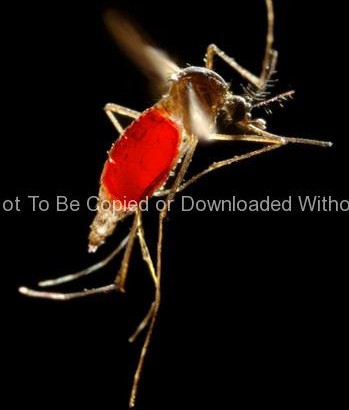
With a newly-obtained fiery red blood meal visible through her transparent abdomen, the now heavy female Aedes aegypti mosquito took flight as she left her host’s skin surface. As it filled with blood, the abdomen became distended, stretching the exterior exoskeletal surface, thereby, causing it to become transparent, allowing the collecting blood to become visible as an enlarging intra-abdominal red mass. The wings seem to be working overtime in order to keep her aloft.
Dengue is a viral disease transmitted by urban Aedes mosquitoes, principally A. aegypti, a species found living in close association with humans in most tropical urban areas. Mosquito biting activity is greatest in the morning for several hours after daybreak and in the late afternoon for several hours before dark. It may feed all day indoors, in shady areas, or when it is overcast. This mosquito breeds in artificial water containers, such as discarded tires, cans, barrels, buckets, 55 gallon drums, flower vases, and cisterns, all frequently found in the domestic environment. Since 1980, the incidence of dengue has increased dramatically in tropical countries worldwide, with endemic and/or epidemic virus transmission documented in most countries of the Caribbean Basin, Central and South America, the Pacific Islands, Asia, and Africa; many countries have had multiple outbreaks. Epidemics are frequently not reported because of inadequate disease surveillance.
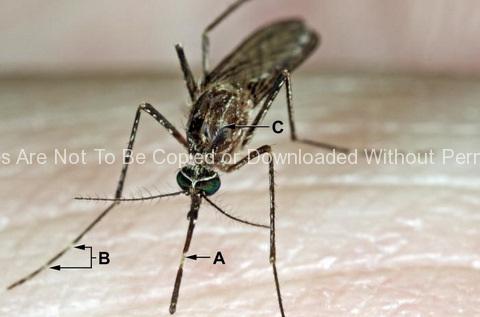
This photograph depicted a close-up view of a Culex tarsalis mosquito as it was about to begin feeding, after having landed on the skin of what will become its human host. Note the light-colored band wrapped around its dark-scaled proboscis (A), and the multiple similarly light-colored bands wrapped around its distal appendages, i.e., the tibia and femur, of its forelegs and middle pair of legs (B), identifying this as C. tarsalis.
Other identifying characteristics include the presence of two silver dots on its dorsal scutum, however, in this particular image, only one of the two bilateral silver scutal marks is visible (C), and a blunted distal abdominal tip, which is not visible in this view. The epidemiologic importance of C. tarsalis lies in its ability to spread Western Equine Encephalitis (WEE), St. Louis Encephalitis (SLE), and California Encephalitis, and is currently the main vector of West Nile virus in the Western United States.
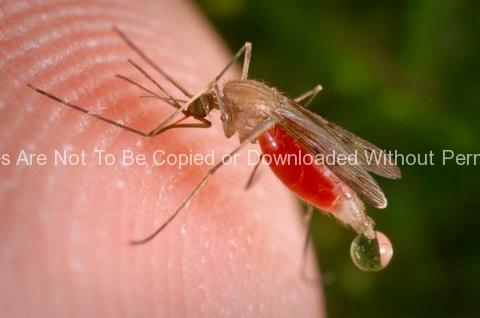
This female Anopheles freeborni is taking a blood meal from a human host by pumping the ingested blood through her “labrum”, which is visible here as a thin red, “needle-like” structure between the mosquito’s head and the host’s skin.
Note her blood-filled, distended abdomen, which is so full that clear, fluid is spilling from the anus at the abdominal tip in order to make room for still more ingested blood. During blood meals taken from persons infected with malaria parasites, the mosquitoes pick up parasites in their sexual forms, known as “gametocytes”. After 10-18 days of further development within the mosquito, the parasites enter their “sporozoite” stage, and can be found in the mosquito’s salivary glands. In this way when the mosquito takes another blood meal, the parasites are introduced into another host, which could be another human being.
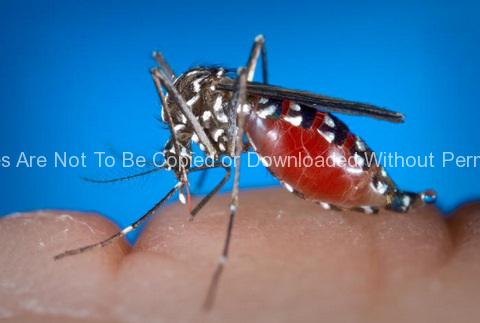
This female Aedes albopictus mosquito is feeding on a human blood meal, thereby, becoming engorged with blood.
Under successful experimental transmission, Aedes albopictus has been found to be a vector of West Nile Virus. Aedes is a genus of the Culicine family of mosquitoes.